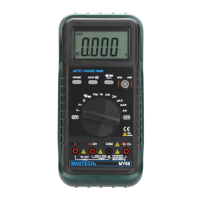The Meter's resistance ranges are 400.0 Ω , 4.000k Ω ,
40.00k Ω , 400.0k Ω , 4.000M Ω and 40.00M Ω .
To
measure resistance:
1. Set the rotary switch to Ω
Ω
Ω
Ω range.
2. Connect the black and red test leads to the COM and
Ω terminals respectively.
3. Connect the test leads to the circuit being measured
and read the displayed value.
Some tips for measuring resistance:
¥ The measured value of a resistor in a circuit is often
different from the resistor's rated value. This is because
the Meter's test current flows through all possible paths
between the probe tips.
¥ In order to ensure the best accuracy in measurement of low
resistance, short the test leads before measurement and
memory the test probe resistance in mind. This necessary to
subtract for the resistance of the test leads.
¥ The resistance function can produce enough voltage to
forward-bias silicon diode or transistor junctions, causing
them to conduct.
To
avoid this, do not use the 40M Ω range
for in-circuit resistance measurements.
¥ On 40M Ω range, the meter may take a few seconds to
stabilize reading. This is normal for high resistance
measuring.
¥ When the input is not connected, i.e. at open circuit,
the figure "OL" will be displayed for the overrange
condition.
15
3.2.3
3.2.3
3.2.3
3.2.3 Diode
Diode
Diode
Diode Test
Test
Test
Test
To
To
To
To avoid
avoid
avoid
avoid electrical
electrical
electrical
electrical shock
shock
shock
shock and/or
and/or
and/or
and/or damage
damage
damage
damage to
to
to
to the
the
the
the
instrument,
instrument,
instrument,
instrument, disconnect
disconnect
disconnect
disconnect circuit
circuit
circuit
circuit power
power
power
power and
and
and
and
discharge
discharge
discharge
discharge all
all
all
all high-voltage
high-voltage
high-voltage
high-voltage capacitors
capacitors
capacitors
capacitors before
before
before
before
testing
testing
testing
testing diodes.
diodes.
diodes.
diodes.
Use the diode test to check diodes, transistors, and other
semiconductor devices. The diode test sends a current
through the semiconductor junction, then measures the
voltage drop across the junction, A good silicon junction
drops between 0.5V and 0.8V.
To
test a diode out of a circuit:
1. Set the rotary switch to range.
2. Press the /
/
/
/ key to activate Diode Test.
3. Connect the black and red test leads to the COM and
V Ω terminals respectively.
4. For forward-bias readings on any semiconductor
component, place the red test lead on the
component's anode and place the black test lead on
the component's cathode.
5. The meter will show the approx. forward voltage of the
diode.
In a circuit, a good diode should still produce a forward bias
reading of 0.5V to 0.8V; however, the reverse-bias reading
can vary depending on the resistance of other pathways
between the probe tips.
16

